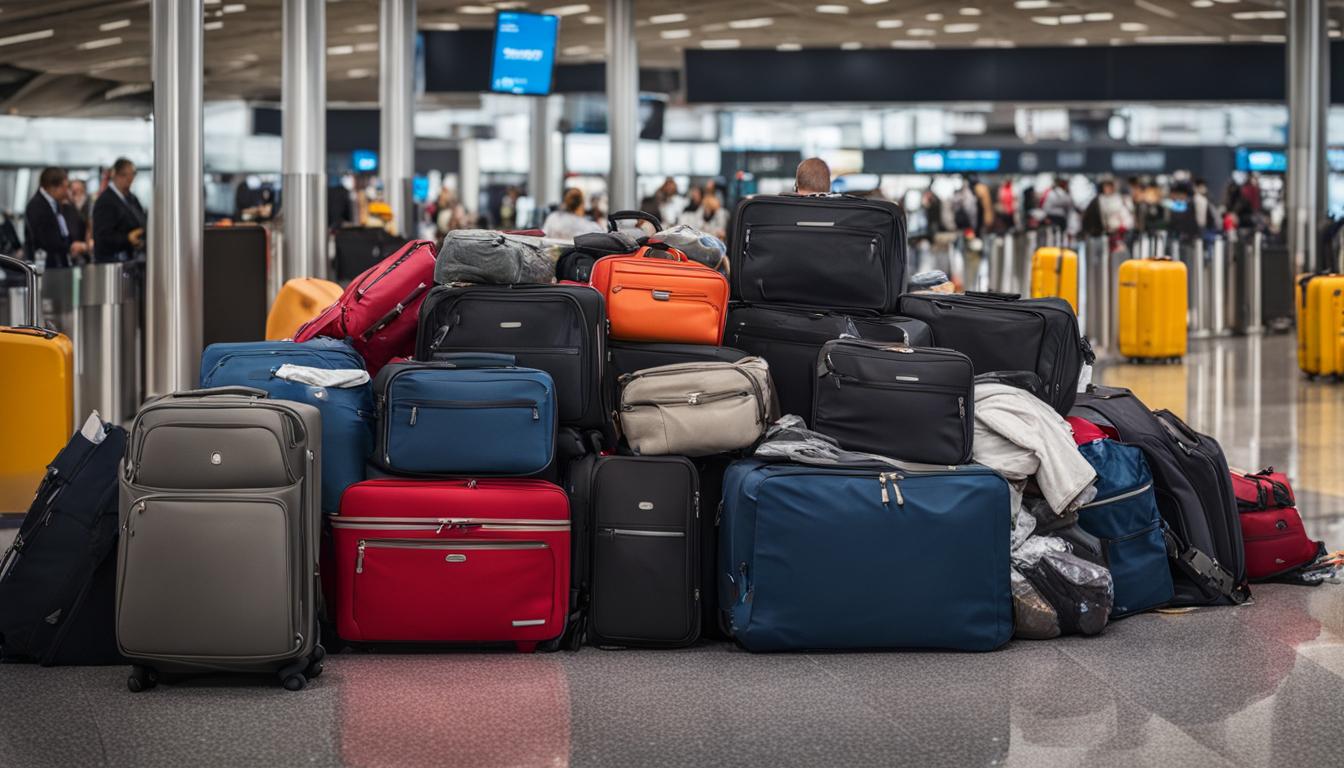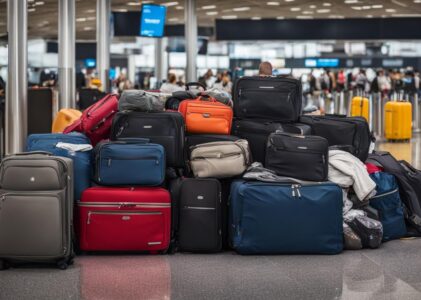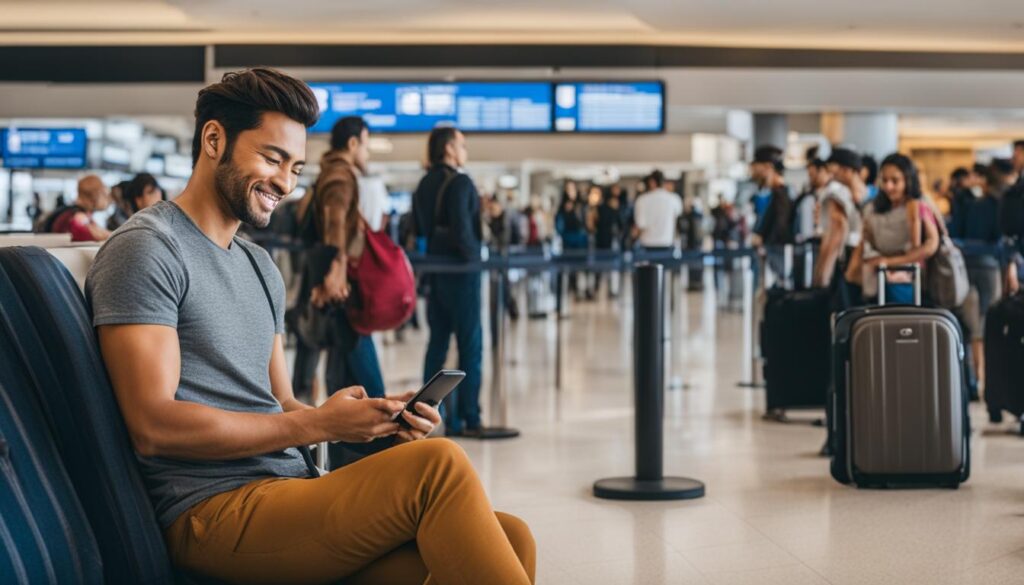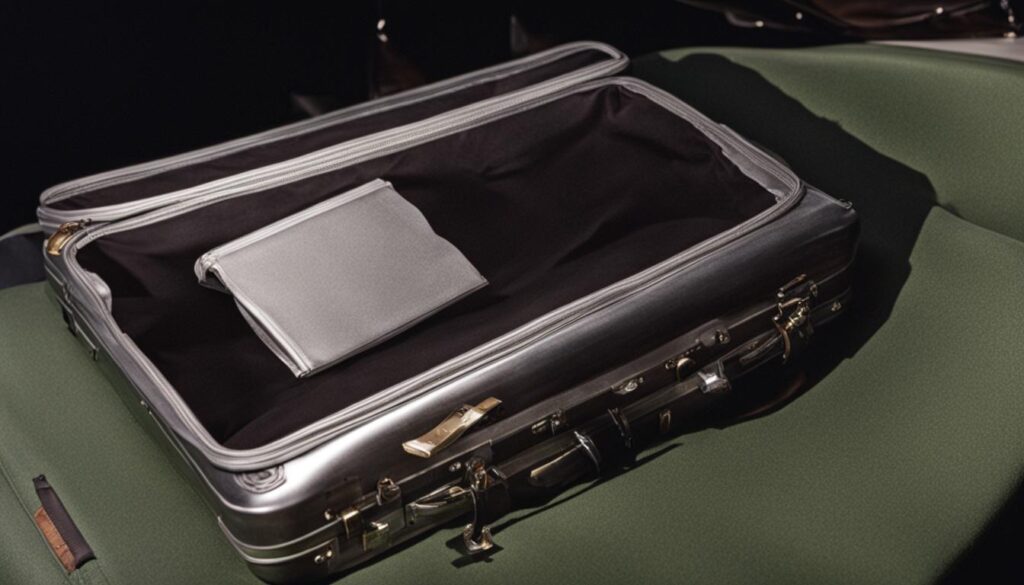Have you ever wondered what happens if your carry-on is too big? Well, I’ve got the answers for you!
When it comes to carry-on size limitations, airline carry-on restrictions can vary. It’s essential to understand the guidelines set by your airline to ensure a smooth travel experience.
Let’s dive into the specifics. American Airlines, for example, has specific requirements for carry-on luggage. Your carry-on bag should have dimensions no larger than 22 inches x 14 inches x 9 inches, including handles and wheels. Going beyond these dimensions means your bag will need to be checked, and you may incur additional fees. And American Airlines isn’t the only one – other airlines also have their own size limitations for carry-on bags.
So, what can you do to avoid any issues with your carry-on? Checking the dimensions allowed by the specific airline you are flying with is crucial. Doing so can help you comply with their regulations and prevent any last-minute surprises or additional fees.
In this article, we’ll explore the carry-on policies of various airlines, discuss the pros and cons of carry-on bags and checked bags, and provide you with helpful tips for choosing the right luggage.
Key Takeaways:
- Each airline has its own specific size requirements for carry-on bags, so make sure to check the dimensions allowed by the airline you are flying with.
- Carry-on bags offer the convenience of having your belongings with you during the flight, while checked bags allow for larger and more items to be packed.
- Consider the size and weight restrictions, durability, and maneuverability when choosing the right luggage for your trip.
- Understanding the baggage fees and policies of the airline you are flying with can help you avoid any surprises or additional costs.
- The decision between carrying on or checking your luggage depends on various factors such as airline policies, size restrictions, convenience, and personal preferences.
American Airlines Carry-On Policy
When flying with American Airlines, it is important to be aware of their carry-on size limitations and restrictions. American Airlines allows passengers to bring either one carry-on bag or a soft-sided garment bag on board. The dimensions for a carry-on bag should be no more than 22 inches x 14 inches x 9 inches, including handles and wheels. If a carry-on bag exceeds these dimensions, it will need to be checked and the passenger may incur a fee.
In addition to the carry-on bag, passengers are also allowed to bring a personal item, such as a small backpack or laptop bag, which should fit securely underneath the seat in front of them. It is important to note that both the carry-on bag and personal item must comply with the airline’s size restrictions.
By adhering to American Airlines’ carry-on policy, passengers can ensure a smooth boarding process and avoid any additional fees or delays. It is always recommended to double-check the specific size limitations and restrictions on the airline’s official website before packing for your trip.
| Carry-On Policy | Dimensions | Allowed Bags |
|---|---|---|
| Carry-On Bag | 22 inches x 14 inches x 9 inches (including handles and wheels) | 1 per passenger |
| Personal Item | Fits securely underneath the seat in front | 1 per passenger |
Remember to pack efficiently and consider the necessary items for your journey. By understanding and complying with American Airlines’ carry-on policy, you can make your travel experience more convenient and hassle-free.
Carry-On Size Requirements for Other Airlines
When it comes to carry-on size limitations, each airline has its own specific requirements. It is important to check the dimensions allowed by the specific airline you are flying with to avoid any issues or additional fees. Here is a comparison of carry-on size restrictions for some major airlines:
| Airline | Carry-On Size Limitations |
|---|---|
| Southwest | Up to 10 x 16 x 24 inches |
| Delta | Up to 22 x 14 x 9 inches |
| United | Up to 22 x 14 x 9 inches |
| JetBlue | Up to 22 x 14 x 9 inches |
| Alaska Airlines | Up to 22 x 14 x 9 inches |
| Hawaiian Airlines | Up to 22 x 14 x 9 inches |
As you can see, there are slight variations in the carry-on size limitations among different airlines. It’s important to note that these dimensions usually include handles and wheels. It is always advisable to check the specific requirements of the airline you are flying with to ensure your carry-on bag meets their guidelines.
In addition to size restrictions, some airlines may also have weight limitations for carry-on bags. The weight limits can vary, so it’s important to verify the weight restrictions as well. By adhering to the size and weight requirements of your chosen airline, you can avoid any potential issues or additional fees when traveling with a carry-on bag.
What Can You Bring in Your Carry-On Bag?
When packing your carry-on bag, it’s important to be aware of the items that are prohibited due to airline security regulations. These restrictions are in place to ensure the safety of all passengers on board. Here are some of the prohibited carry-on items:
- Firearms: Firearms, including guns and ammunition, are strictly prohibited in carry-on bags. They must be transported in checked luggage and declared to the airline.
- Liquids in containers larger than 3.4 ounces: The Transportation Security Administration (TSA) limits the amount of liquid that can be brought in a carry-on bag. Each container must not exceed 3.4 ounces and must be placed in a clear, quart-sized bag.
- Sharp objects: Sharp objects such as knives, scissors, and box cutters are not allowed in carry-on bags. These items must be packed in checked luggage.
- Explosives and flammable items: Explosives, flammable liquids, and gases are strictly prohibited in carry-on bags. These items pose a significant risk to the safety of the aircraft and must be transported in checked luggage.
It’s important to review the guidelines provided by the TSA before packing your carry-on bag to ensure compliance with airline regulations. By adhering to these guidelines, you can help to maintain a safe and secure travel environment for everyone on board.
| Prohibited Items | Carry-On | Checked Bag |
|---|---|---|
| Firearms | No | Yes (with declaration) |
| Liquids > 3.4 ounces | No | Yes (in clear, quart-sized bag) |
| Sharp objects | No | Yes |
| Explosives & flammable items | No | Yes |
Checked Bags vs Carry-On Bags
When it comes to traveling, one of the decisions you have to make is whether to check your luggage or carry it on. Both options have their pros and cons, and it’s important to consider your specific needs and preferences. Let’s take a closer look at the differences between checked bags and carry-on bags.
Checked Bags
Checked bags are placed in the cargo hold of the airplane and are inaccessible during the flight. This means that you won’t have immediate access to your belongings while in the air. However, checked bags allow for larger and more items to be packed, making them a good option for longer trips or when you need to bring extra items such as sports equipment or bulky winter clothing. It’s important to note that checked bags may have size and weight limitations, and airlines may charge additional fees for checking them.
Carry-On Bags
Carry-on bags, on the other hand, are brought into the cabin with you and placed in the overhead compartment or underneath the seat in front of you. This ensures that you have your belongings with you at all times during the flight, providing convenience and peace of mind. Carry-on bags are typically smaller and have size restrictions imposed by the airline. They are also subject to security screening. While carry-on bags offer the benefit of not having to wait at baggage claim and the reduced risk of lost or damaged luggage, they can be heavy and difficult to maneuver, especially in crowded airports.
The Decision
Ultimately, the decision between checked bags and carry-on bags depends on various factors such as the length of your trip, the amount of belongings you need to bring, and your personal preferences. If you’re traveling light and don’t want the hassle of waiting at baggage claim, a carry-on bag may be the best option. On the other hand, if you need to bring more items or have special equipment, checking your bags might be the better choice. Consider the specific requirements and fees of the airline you are flying with to make an informed decision.
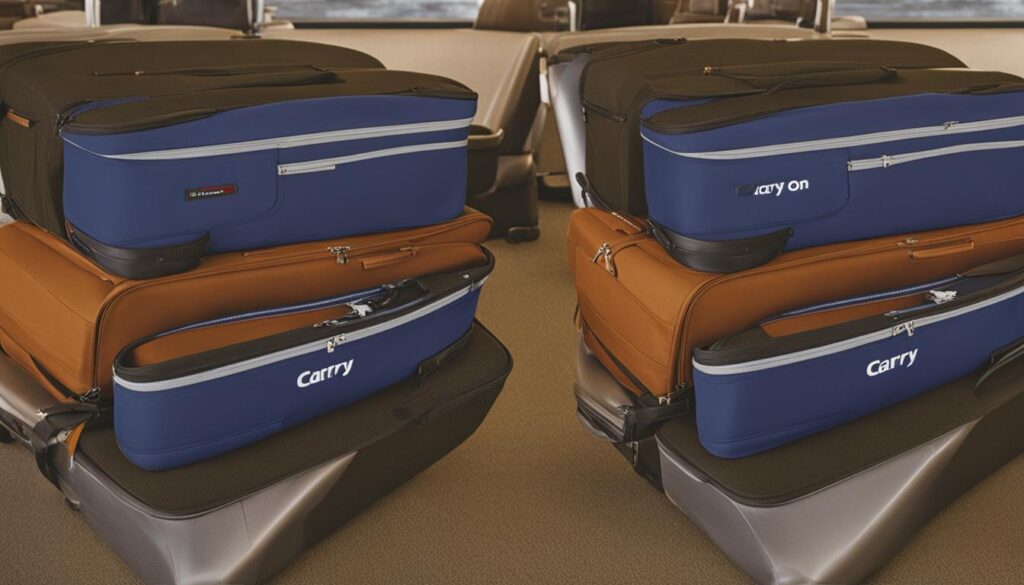
| Checked Bags | Carry-On Bags | |
|---|---|---|
| Convenience | Less convenient due to waiting at baggage claim | Convenient as you have immediate access to your belongings |
| Luggage Size | Allows for larger and bulkier items | Smaller size with restrictions imposed by the airline |
| Luggage Fees | Additional fees may apply | No additional fees for carry-on bags that meet size requirements |
| Risk of Lost or Damaged Luggage | Potential risk | Reduced risk as you have your belongings with you |
Pros and Cons of Carry-On Bags
When it comes to travel, deciding whether to bring a carry-on bag or check your luggage is a common dilemma. Carry-on bags offer several advantages that make them a popular choice for many travelers. Let’s take a look at some of the pros and cons of carry-on bags:
Pros of Carry-On Bags:
- Convenience: One of the main benefits of carry-on bags is the convenience they provide. Having your belongings with you throughout the flight allows for easy access to essential items like medications, electronics, and personal documents.
- Time-saving: With a carry-on bag, you can skip the long waits at baggage claim and proceed directly to your destination after landing. This can save you valuable time, especially if you have a tight connection or need to catch a connecting flight.
- Cost-saving: Many airlines charge fees for checked bags, and these costs can quickly add up, especially if you frequently travel. By bringing a carry-on bag, you can avoid these additional expenses.
Cons of Carry-On Bags:
- Size Restrictions: Carry-on bags must comply with the airline’s size limitations, which can vary between different carriers. If your bag exceeds the allowed dimensions, you may be required to check it or pay additional fees.
- Limited Space: Carry-on bags are typically smaller in size compared to checked luggage, which means you have less space to pack your belongings. This can be a challenge, especially for longer trips or if you need to pack bulky items.
- Heavy to Maneuver: Carrying a heavy carry-on bag through crowded airports, up and down stairs, and along narrow aisles can be physically demanding. It’s important to consider the weight of your bag and your own physical capabilities when choosing to bring a carry-on.
In summary, carry-on bags offer the convenience of having your belongings with you, saving time at the airport, and avoiding extra costs for checked baggage. However, they do come with size limitations, limited space, and the potential for added weight and physical strain. Consider your travel needs, duration, and personal preferences when deciding whether to bring a carry-on bag or check your luggage.
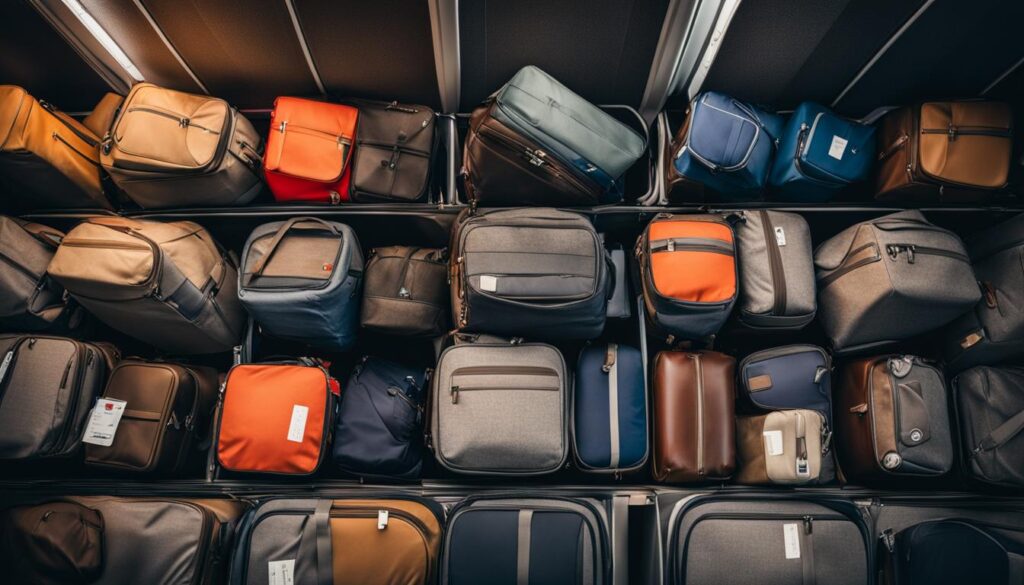
Pros and Cons of Checked Bags
When it comes to choosing between checked bags and carry-on bags, there are several factors to consider. Let’s take a closer look at the pros and cons of checked bags:
Advantages of Checked Bags
- More items: One of the main advantages of checked bags is that they allow for larger and more items to be packed. This is especially beneficial for longer trips or if you need to bring bulky items.
- Convenience: Checking your bags can also be more convenient, as you don’t have to carry them through the airport or worry about finding space in the overhead compartment. It can make navigating the airport and boarding the plane easier.
- Banned items: Checked bags also eliminate the hassle of going through security with liquids and other restricted items. You can pack all your toiletries and other prohibited items in your checked bag without any issues.
Disadvantages of Checked Bags
- Additional fees: One of the main downsides to checked bags is the potential for additional fees. Many airlines charge fees for checked bags, which can add up depending on the number of bags and their weight.
- Risk of loss or delay: Another disadvantage of checked bags is the risk of lost or delayed luggage. If your checked bag doesn’t make it to your destination on time, it can be inconvenient and disrupt your travel plans.
- Lack of accessibility: Once you check your bag, you won’t have immediate access to your items during the flight. This can be especially inconvenient if you need something from your bag during the flight.
Overall, checked bags offer the advantage of being able to bring more items and eliminate the need to carry them through the airport. However, they come with the potential for additional fees and the risk of lost or delayed luggage. Consider your travel needs and preferences to determine if checking your bags is the right choice for you.
Table: Comparison of Checked Bags
| Advantages | Disadvantages |
|---|---|
| Allows for more items | Potential for additional fees |
| Convenient for navigating the airport | Risk of loss or delay |
| Eliminates the need to carry bags | Lack of accessibility during the flight |
Baggage Fees and Policies
When it comes to traveling, it’s essential to familiarize yourself with the baggage fees and policies of the airline you are flying with. These fees can vary significantly and can have an impact on your overall travel expenses. Additionally, understanding the policies surrounding baggage can help you avoid any surprises or additional costs.
To give you a better understanding, I have compiled a table outlining the baggage fees and policies of some popular airlines:
| Airline | First Bag Fee | Second Bag Fee | Overweight Bag Fee | Oversize Bag Fee |
|---|---|---|---|---|
| American Airlines | $30 | $40 | $100 | $200 |
| Delta Airlines | $30 | $40 | $100 | $200 |
| United Airlines | $30 | $40 | $100 | $200 |
Keep in mind that these fees are subject to change, so it’s always a good idea to check with the airline directly or visit their website for the most up-to-date information. Some airlines may offer free checked bags for certain fare types or elite status holders, so be sure to take advantage of any benefits you may have.
It’s also important to be aware of the baggage weight and size limitations imposed by the airline. Exceeding these limits can result in additional fees. To avoid any surprises, pack strategically and consider investing in lightweight luggage to minimize the risk of going over the weight allowance.
Tips for Choosing the Right Luggage
Choosing the right luggage for your trip is essential to ensure a smooth and hassle-free travel experience. Whether you prefer a carry-on bag or a checked bag, there are a few key factors to consider. I’ve compiled some tips to help you make the best decision for your travel needs.
Size and Weight Restrictions
Before purchasing luggage, familiarize yourself with the size and weight restrictions imposed by the airline you’ll be flying with. Different airlines have varying requirements, so it’s important to choose a bag that meets their guidelines. Opt for lightweight options that maximize your packing capacity within the permitted dimensions.
Duration of Your Trip
Another factor to consider is the length of your trip. If you’re only going away for a few days or a weekend getaway, a carry-on bag might be sufficient. This option allows you to avoid checked baggage fees and saves time at the airport. However, for longer trips, you may need the additional space of a checked bag to accommodate your belongings.
Maneuverability and Special Features
When selecting luggage, consider the ease of maneuverability. Look for bags with sturdy wheels and telescopic handles for smooth navigation through airports and other travel destinations. Additionally, think about any special features that may be useful to you, such as built-in USB ports for charging devices or compartments for organizing your belongings.
By taking these factors into account, you can choose the right luggage that aligns with your travel needs and helps make your journey more convenient and enjoyable.
| Carry-On Bag | Checked Bag | |
|---|---|---|
| Size Restrictions | Fits airline’s specified dimensions for carry-on bags | Varies by airline; usually larger than carry-on size |
| Convenience | Easily accessible during flight; no need to wait at baggage claim | Placed in the cargo hold; not accessible during flight |
| Cost | No checked baggage fees | May incur additional fees depending on the number of bags and airline policies |
| Packing Capacity | Limited space; suitable for shorter trips | More room for belongings; ideal for longer trips |
| Risk of Loss/Delay | Bag is with you at all times; minimal risk of loss or delay | Potential risk of lost or delayed luggage |
Conclusion
After considering the various factors, it’s clear that the decision between carrying on or checking your luggage depends on your specific needs and preferences. Both options have their pros and cons, so it’s essential to assess what matters most to you.
If convenience and peace of mind are your top priorities, then a carry-on bag is the way to go. Having your belongings with you during the flight eliminates the risk of lost or delayed luggage and allows for easy access to your essentials. Additionally, you can bypass the baggage claim process, saving you time and potential stress.
On the other hand, if you’re planning a longer trip or need to pack more items, a checked bag might be the better choice. Checked bags offer more space to accommodate your belongings, and you don’t have to worry about carrying them through the airport or complying with size restrictions. However, it’s crucial to consider the potential fees and the risk of your luggage being lost or damaged.
Ultimately, the decision between carry-on and checked bags comes down to what works best for you. Take into account the specific policies of the airline you’re flying with, your travel needs, and your personal preferences. By making an informed choice, you can ensure a smooth and stress-free travel experience.
FAQ
What happens if your carry-on is too big?
If your carry-on bag exceeds the size limitations set by the airline, it will need to be checked and you may have to pay a fee.
What are the carry-on size limitations for American Airlines?
American Airlines requires carry-on bags to have dimensions no larger than 22 inches x 14 inches x 9 inches, including handles and wheels.
What are the carry-on size requirements for other airlines?
Each airline has its own specific size limitations for carry-on bags. It is important to check the dimensions allowed by the specific airline you are flying with to avoid any issues or additional fees.
What items are prohibited from being brought in a carry-on bag?
Prohibited items in carry-on bags include firearms, liquids in containers larger than 3.4 ounces, sharp objects, explosives, and flammable items. It is important to review the Transportation Security Administration (TSA) guidelines for a complete list of prohibited items.
What is the difference between checked bags and carry-on bags?
Checked bags are placed in the cargo hold of the airplane and are inaccessible during the flight, while carry-on bags are brought into the cabin. Checked bags may have size and weight limitations and may incur additional fees, while carry-on bags must comply with the airline’s size restrictions and are subject to security screening.
What are the pros and cons of carry-on bags?
Carry-on bags offer the convenience of having your belongings with you during the flight and avoiding the need to wait at baggage claim. However, they may be heavy and difficult to maneuver, and they can be subject to size restrictions and additional fees.
What are the pros and cons of checked bags?
Checked bags allow for larger and more items to be packed, without the need to carry them through the airport. However, they may be subject to size and weight limitations, as well as additional fees. There is also the risk of lost or delayed luggage.
How much do airlines charge for checked bags?
Baggage fees for checked bags vary by airline and are typically based on the number of bags and their weight. Some airlines offer free checked bags for certain fare types or elite status holders. It is important to check the baggage fees and policies of the airline you are flying with.
What should I consider when choosing luggage?
When choosing luggage, consider the size and weight restrictions of the airline you are flying with. Look for durable and lightweight options that meet the requirements for carry-on or checked bags. Consider the length of your trip and the amount of belongings you need to pack.
Should I carry on or check my luggage?
The decision between carrying on or checking your luggage depends on various factors such as airline policies, size restrictions, convenience, and personal preferences. Consider your travel needs and requirements when making the decision.

